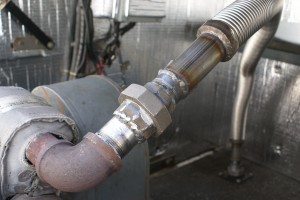Linda worked all day on the accounting for Service Motors. Butch and I drove to Logansport first thing in the morning to get various parts for the bus projects. When we got back, Butch welded unions on either end of the bendable exhaust while I worked on the water pump issue. On the genset end, one part of the union was welded to a cut-off pipe nipple and then threaded into the outlet from the GenSet turbocharger. The mating part for the other end was already installed in the floor of the generator bay. We secured the pipe with the unions on each end and ran the genset to check for leaks. Seeing none, we bent the pipe into its initial/open position. I them wrapped it in 2” wide fiberglass header heat wrap, using a 50% overlap, and secured it with hose clamps. We tested it again and say no evidence of leaks, so we slide the genset back into the bay and coaxed the pipe into its final/closed position. It now works well and looks nice.
The fresh water pump is connected to the coach plumbing by 30” long hoses whose purpose,
beyond allowing the connections to be made, is to isolate the plumbing from the vibration of the pump. We disconnected the pump outlet hose from the plumbing and checked the pump flow by pumping the discharge into a bucket. The flow was not good. We then attached the hoses so we could draw water out of the bucket and pump it into the fresh water tank, thus back flushing the supply (suction) line. That seemed to improve the flow a bit. We also drew from the bucket to test the outgoing lines to house and that flow was also quite restricted.
One of the problems with bus conversions is that they are essentially one-of-a-kind vehicles built to the requirements of specific original buyers. To that extent they are custom built more than they are engineered, and that really shows up in the systems that are hidden from view. Our fresh water system was built with two supply lines from the fresh water tank to the water pump. These lines leave the fresh water tank on the driver side near the floor of the bay and are routed up and over
the fresh water tank to the other side of the bay and back down to a compartment about 18 inches above the bay floor. This is definitely not a good design as water pumps like the Shur-Flo 4048 are not designed to draw very hard on the vacuum side. We back-flushed the other supply line and them plumbed the two lines together using additional short hose sections, plastic pipe nipples, and black iron pipe connectors. The flow was improved a bit, and we decided it was as good as we were going to make it for now.
Long term the better solution will be to relocate the water pump to the driver side of the bay and mount it at floor level near where the water exits the fresh water tank, which will eliminate the draw on the vacuum side. I will then attach the outlet of the pump to a new, larger supply line and route it to the other side of the bay and then redo the plumbing in that compartment to eliminate as many
of the right angle fittings, T-fittings, and valves as possible.
In the midst of all this work we also discovered that the middle (kitchen) air-conditioner was not producing any cooling. Butch, among many other things, is an HVAC guy, and suggested we take a look at the three house AC units before we left the next morning. Knowing that we would be spending much of the summer in the high plains and mountains of the west, that sounded like a good idea to us.
While it was not our intent to work on the Zena power generator, I was able to pick up some welding cable and crimp on terminal lugs and make the battery connection cables using Butch’s press. They did not get installed, however, as I still need to locate and mount a fuse holder for a Class-T fuse.
A good day’s work done, we headed to Logansport for dinner at Pizza Hut. Pizza hut serves various pasta dishes, but they all involve meat sauce and/or cheese. We had a thin-crust pizza with no cheese, and it was OK. They also have a salad bar, and that was OK too.
